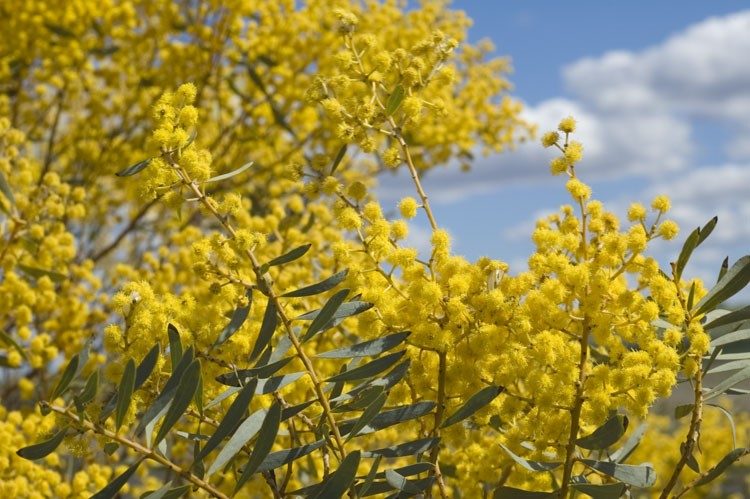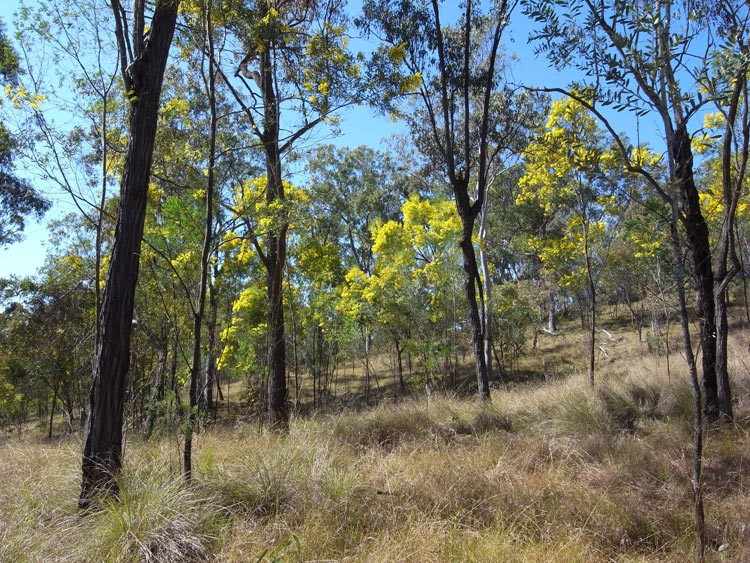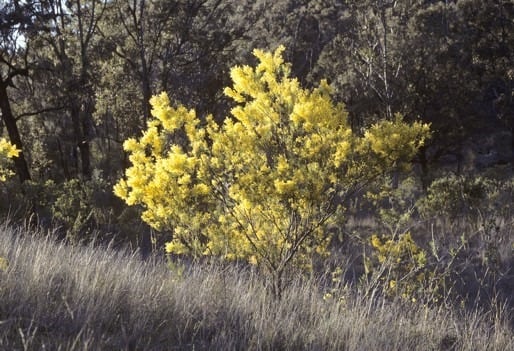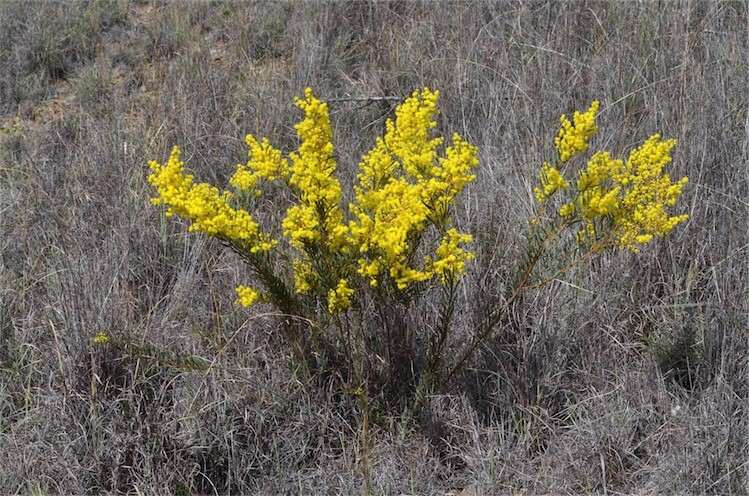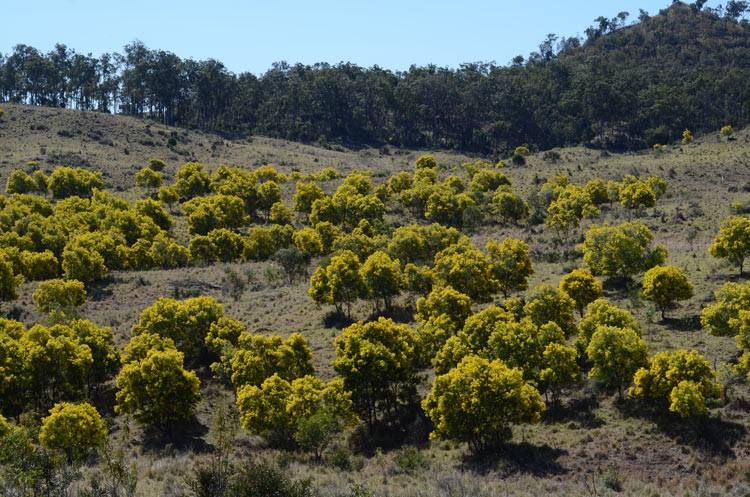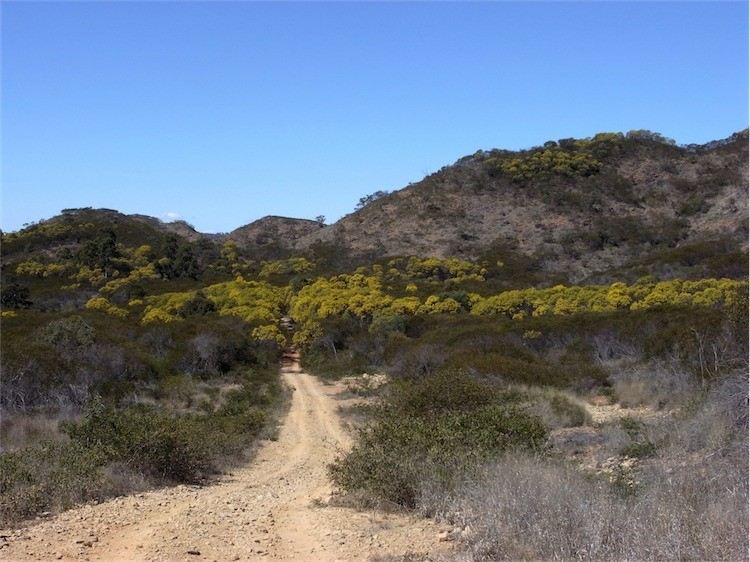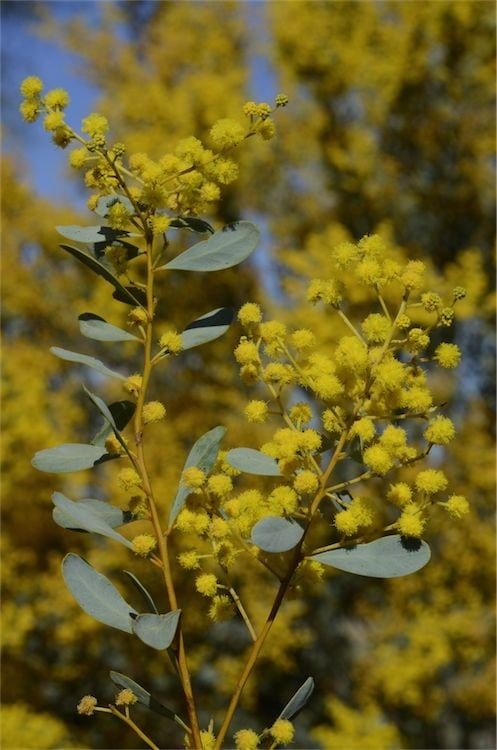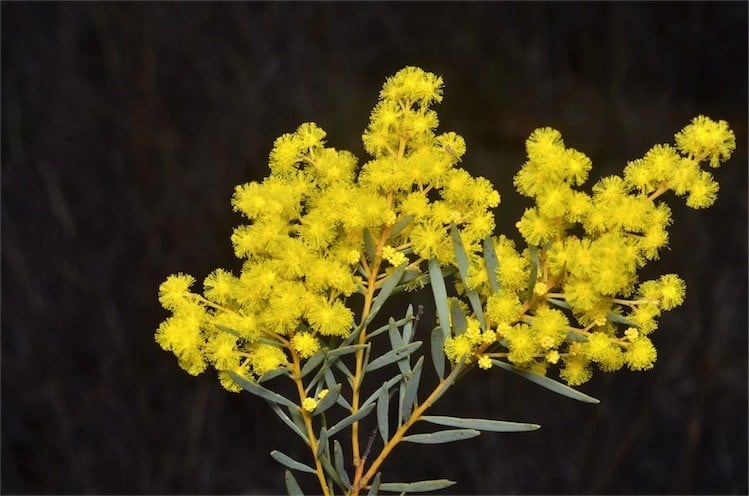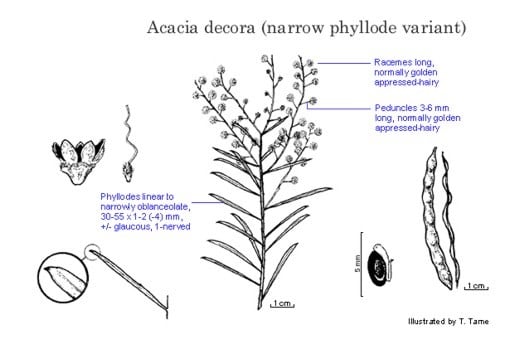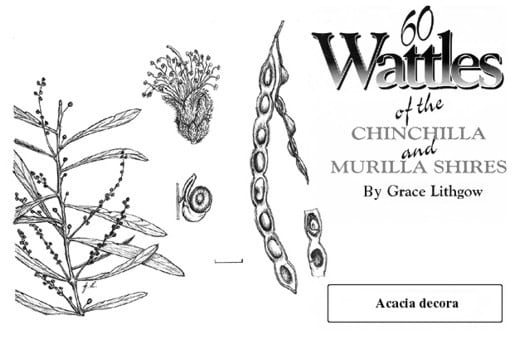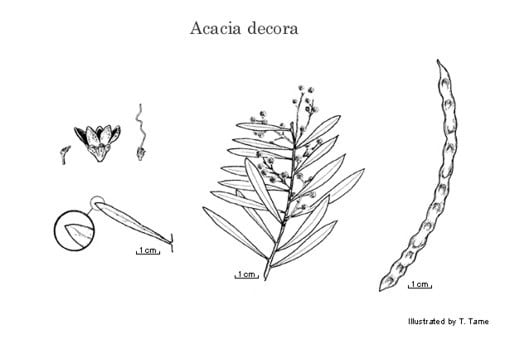Acacia decora Rchb.
WATTLE
Acacias of Australia
Common Name
Western Silver Wattle, Showy Wattle, Western Golden Wattle and many others
Family
Fabaceae
Distribution
Widespread in eastern Australia from the Palmer R. area, north Qld, through N.S.W. to Wangaratta, Vic.
Description
Shrub normally 1–3 m high. Branchlets ribbed, glabrous or sometimes appressed-puberulous, hairs rarely ±patent. Phyllodes on raised stem-projections, often patent, oblanceolate to narrowly oblanceolate, narrowly elliptic or ±linear, (1.5–) 2–6 cm long, usually 3.5–10 mm wide, narrowed at base, obtuse to acute, grey-green to glaucous, usually glabrous, 1-nerved per face; lateral nerves obscure or absent; glands 1 or 2, with lowermost normally 5–15 mm above pulvinus. Inflorescences prolific racemes in upper axils; raceme axes usually 2–6 cm long, appressed-puberulous with white or golden hairs; peduncles 3–6 (–9) mm long, usually appressed-puberulous, with hairs golden but sometimes white in fruit; heads globular, 15–30-flowered, golden. Flowers 5‑merous; sepals united. Pods to 11 cm long, 4–9 mm wide, firmly chartaceous to thinly coriaceous, sometimes ±pruinose, glabrous. Seeds longitudinal, ±oblong, 4–6 mm long, ±shiny, black; funicle-aril 1/2–3/4 length of seed. Western Silver Wattle, Showy Wattle, Western Golden Wattle and many others.
Habitat
Commonly grows on rocky ridges or outcrops, in Eucalyptus communities, sometimes as pure stands.
Specimens
Qld: near Croydon, P.D.Hind 1038 & C.K.Ingram (BRI, NSW); Mt Molloy–Cooktown road 15.1 km N of Palmer R., I.B.Staples 2191 (BRI, MEL). N.S.W.: 13 km NE of Boorowa on road to Crookwell, B.R.Maslin 5891 (MEL, PERTH); 'Ellerslie’, NW of Wielmoringle, W.E.Mulham 1081 (NSW). Vic.: 5 km E of Dookie on Devenish Rd, J.Stuwe 631 (MEL).
Notes
Acacia caleyi was treated as a distinct species by B.R.Maslin, Fl. Australia 11A: 305 (2001), but it is now considered best treated as a variant within A. decora. Plants referred to this entity are found near Griffith, N.S.W., and are characterized primarily by the ±spreading, often curved or crisped hairs on their branchlets, phyllodes, raceme axes and often peduncles. Elsewhere in A. decora the raceme axes and peduncles have ±straight, closely appressed hairs; the phyllodes and branchlets are normally glabrous but if hairs are present (mainly Victorian populations) they are closely appressed.
Sometimes sympatric with A. polifolia in Qld, which is distinguished by its appressed-puberulous branchlets and generally longer, appressed-puberulous phyllodes. In the field these two species may be confused with A. deuteroneura. The habit of A. hamiltoniana may resemble that of A. decora.
Putative hybrids with A. vestita and another with A. conferta are noted under those species.
L.Pedley, Austrobaileya 1: 296 (1980), noted a low spreading habit variant with narrow phyllodes (to 3 mm wide) from the Inglewood district, Qld (e.g. T.J.McDonald 362, BRI). Plants with ±linear, very narrow phyllodes, commonly 1–2 mm wide, occur in the Hunter R. area, N.S.W. (e.g. B.R.Maslin 5920, MEXU, NSW, PERTH). These are multistemmed shrubs to c. 1.2 m high and are confined to areas of shaly clay. These entities were treated as A. decora (narrow phyllode variant) in B.R.Maslin (coordinator), Acacias of Australia CD-ROM (2001).
Acacia decora sometimes resembles A. buxifolia which is distinguished especially by its normally glabrous raceme axes and peduncles.
A somewhat variable species but generally recognised by its relatively short, commonly oblanceolate phyllodes and long racemes with often light golden, normally appressed hairs on their axes and peduncles. The glands are small and normally slightly exserted, the lowermost usually being situated 5–15 mm above the pulvinus and sometimes connected to the midrib by a fine oblique nerve. The phyllode margin is commonly slightly indented at the gland. Racemes occasionally reach 12 cm long (e.g. 9 km from Chinchilla on the Burnett Hwy, Qld, V.Hando 18, PERTH).
FOA Reference
Data derived from Flora of Australia Volumes 11A (2001), 11B (2001) and 12 (1998), products of ABRS, ©Commonwealth of Australia
Author
Revised by B.R.Maslin
B.R.Maslin
This identification key and fact sheets are available as a mobile application:
URL: https://apps.lucidcentral.org/wattle/
© Copyright 2018. All rights reserved.

